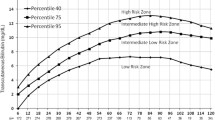Abstract
Routine bilirubin screening prior to newborn hospital discharge, using an hour-specific bilirubin nomogram, has been advocated to assess risk for subsequent severe hyperbilirubinemia. However, the false-negative rate has never been adequately studied. Our objective was to determine false-negative results of pre-discharge bilirubin screening. After routine pre-discharge, bilirubin screening was in place for over 4 years, we performed a retrospective chart review to identify infants readmitted for total bilirubin levels > 17 mg/dl (>290.7 μmol/l). We documented each infant's pre-discharge bilirubin level, risk-zone assignment by nomogram, the presence or absence of risk factors for severe hyperbilirubinemia, co-morbidities upon readmission, treatment received, and ultimate disposition. Readmitted infants whose pre-discharge bilirubin was in the low-risk (<40th percentile) and low-intermediate (40–75th percentile) risk zones of the nomogram, were considered false-negatives. Of the 6,220 infants discharged from the newborn nursery during the 51-month study period, 28 (0.45%) were readmitted for treatment of serum bilirubin levels > 17 mg/dl (>290.7 μmol/l). All received phototherapy and none required exchange transfusion. Pre-discharge bilirubin values were <40th percentile (low-risk zone) in one infant (3.6%), and between 40–75th percentiles (low-intermediate risk zone) in twelve infants (43%). Risk factors for the development of severe hyperbilirubinemia were present in 27 (96%) readmitted infants. In conclusion, nearly half of readmitted infants had pre-discharge bilirubin values in zones considered at lower risk. The use of pre-discharge bilirubin screening alone to assign future risk for severe hyperbilirubinemia may provide false reassurance. Rigorous research is required to determine the test characteristics of pre-discharge bilirubin screening before widespread acceptance and implementation. Universal early post-discharge follow-up should remain the cornerstone of preventing severe hyperbilirubinemia.

Similar content being viewed by others
Abbreviations
- TSB:
-
total serum bilirubin
- TCB:
-
transcutaneous bilirubin
- G6PD:
-
glucose-6-phosphate dehydrogenase deficiency
- AAP:
-
American Academy of Pediatrics
- PDB:
-
pre-discharge bilirubin
References
AAP Subcommittee on Neonatal Hyperbilirubinemia (2001) Neonatal jaundice and kernicterus. Pediatrics 108:763–765. doi:10.1542/peds.108.3.763
American Academy of Pediatrics policy statement (2004) Levels of neonatal care. Pediatrics 114:1341–1347
American Academy of Pediatrics Subcommittee on Hyperbilirubinemia (2004) Management of hyperbilirubinemia in the newborn infant 35 or more weeks of gestation. Pediatrics 114:297–316. doi:10.1542/peds.114.1.297
Bhutani VK, Johnson L, Sivieri EM (1999) Predictive ability of a pre-discharge hour-specific serum bilirubin for subsequent significant hyperbilirubinemia in healthy term and near-term newborns. Pediatrics 103:6–14. doi:10.1542/peds.103.1.6
Eggert LD, Wiedmeier SE, Wilson J, Christensen RD (2006) The effect of instituting a prehospital-discharge newborn bilirubin screening program in an 18-hospital health system. Pediatrics 117:e855–e862. doi:10.1542/peds.2005-1338
Johnson LH, Bhutani VK, Brown AK (2002) System-based approach to management of neonatal jaundice and prevention of kernicterus. J Pediatr 140:396–403. doi:10.1067/mpd.2002.123098
Joint Commission on Accreditation of Healthcare Organizations (2001). Sentinel Event Alert 18:1–4.
Kaplan M, Bromiker R, Schimmel MS et al (2007) Evaluation of discharge management in the prediction of hyperbilirubinemia: the Jerusalem experience. J Pediatr 150:412–417. doi:10.1016/j.jpeds.2006.12.014
Keren R, Bhutani VK, Luan X et al (2005) Identifying newborns at risk of significant hyperbilirubinaemia: a comparison of two recommended approaches. Arch Dis Child 90:415–421. doi:10.1136/adc.2004.060079
Maisels MJ, Kring EA (2006) Routine transcutaneous bilirubin (TcB) measurements in the nursery predict the risk of subsequent hyperbilirubinemia. E-PAS 2006:5575.479 Available at http://www.abstracts2view.com/pasall/. Accessed 10 Jan 2009
Maisels MJ, Newman TB (1999) Predicting hyperbilirubinemia in newborns: the importance of timing. Pediatrics 103:493–495. doi:10.1542/peds.103.2.493
Maisels MJ, Newman TB, Watchko JF (2006) Effect of pre-discharge bilirubin screening on subsequent hyperbilirubinemia. Pediatrics 118:1796. doi:10.1542/peds.2006-1456
McGinn T, Guyatt G, Wyer P et al (2002) Clinical prediction rules. In: Guyatt G, Rennie D (eds) Users’ guides to the medical literature: a manual for evidence-based clinical practice. American Medical Association, Chicago, pp 471–483
Newman TB, Liljestrand P, Escobar GJ (2005) Combining clinical risk factors with serum bilirubin levels to predict hyperbilirubinemia in newborns. Arch Pediatr Adolesc Med 159:113–119. doi:10.1001/archpedi.159.2.113
Paul IM, Phillips TA, Widome MD, Hollenbeak CS (2004) Cost-effectiveness of postnatal home nursing visits for prevention of hospital care for jaundice and dehydration. Pediatrics 114:1015–1022. doi:10.1542/peds.2003-0766-L
Rubaltelli FF, Gourley GR, Loskamp N et al (2001) Transcutaneous bilirubin measurement: a multicenter evaluation of a new device. Pediatrics 107:1264–1271. doi:10.1542/peds.107.6.1264
Strauss SE, Richardson WS, Glasziou P, Haynes RB (2005) Diagnosis and screening. In: evidence-based medicine: how to practice and teach EBM, 3rd edn. Churchill Livingstone, Edinburgh, pp 67–99
Acknowledgment
The authors would like to thank Pat Wagstaff RN, MHA (Outcome Manager, MUSC Center for Clinical Effectiveness and Patient Safety) for her assistance in searching the patient billing database.
Ethical standards
This study was reviewed and approved by the Institutional Review Board (IRB) of the Medical University of South Carolina and has been performed in accordance with the ethical standards laid down by the 1964 Declaration of Helsinki. All details that might disclose the identity of patients has been removed. As the study was retrospective, no subjects were contacted by the research team and informed consent was waived by the IRB.
Competing interests
The authors declare that they have no conflict of interest.
Funding
This study was unfunded.
Author information
Authors and Affiliations
Corresponding author
Rights and permissions
About this article
Cite this article
Slaughter, J., Annibale, D. & Suresh, G. False-negative results of pre-discharge neonatal bilirubin screening to predict severe hyperbilirubinemia: a need for caution. Eur J Pediatr 168, 1461–1466 (2009). https://doi.org/10.1007/s00431-009-0950-z
Received:
Accepted:
Published:
Issue Date:
DOI: https://doi.org/10.1007/s00431-009-0950-z



